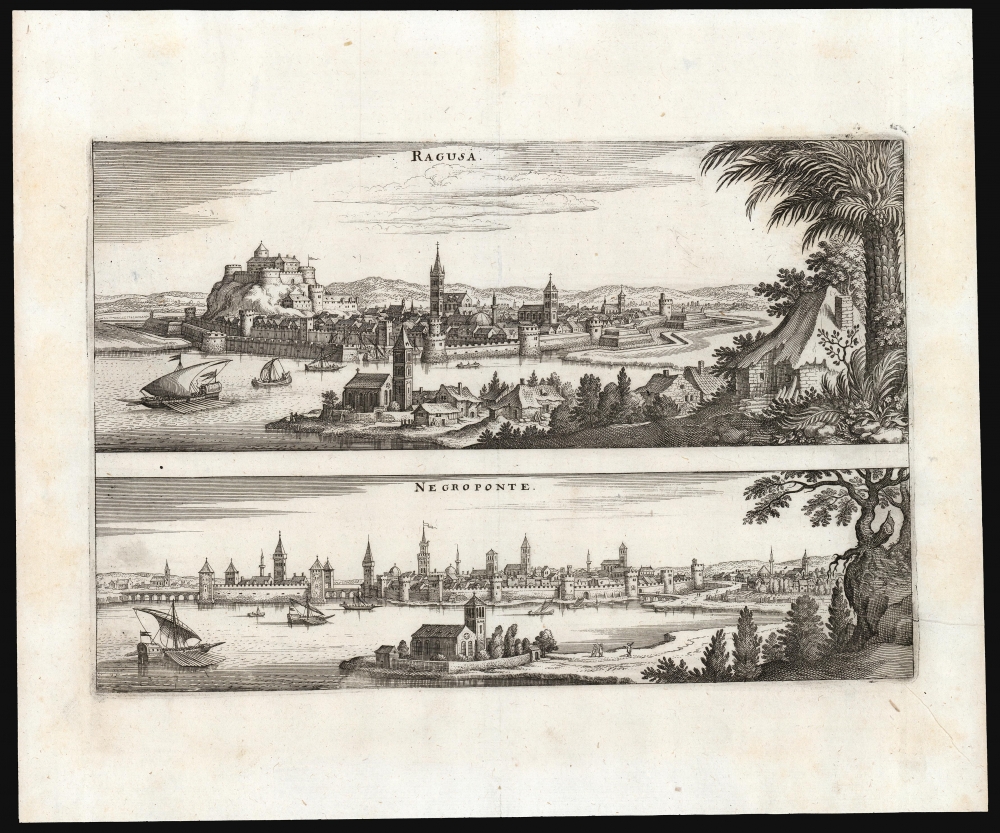1638 Matthias Merian Views of Ragusa (Dubrovnik) and Negroponte (Chalcis)
RagusaNegroponte-merian-1638
Title
1638 (undated) 8 x 12 in (20.32 x 30.48 cm)
Description
Ragusa
Medieval Ragusa, now Dubrovnik, was a Venetian territory and a vital link in the spice trade. When the Portuguese established a sea route around Africa to the spice islands, the overland spice trade dried up, but Ragusa was able to maintain influence by carefully balancing the interests of Venice with those of the Ottoman Empire. Their merchant fleet was able to travel freely in the territories of both powers. In 1667, Ragusa suffered a catastrophic earthquake, taking as many as 5,000 lives and flattening most of the structures visible here. Dubrovnik's famous city walls survived the earthquake and thus are more recognizable - both the old medieval walls facing the water and the more modern fortifications facing land.Negroponte
The ancient name, literally meaning 'Black Bridge,' refers to the city of Chalcia on the Greek island of Euboea - where it spanned the narrowest gap of the Euripus Strait, separating the island from the mainland. Formerly a Venetian state, since 1470 it had been an Ottoman territory. Its strategic position was such that the Ottomans made the city the 'Seat of the Admiral of the Archipelago.'Publication History and Census
This map was executed in 1638 for inclusion in Matthias Merian's Neuwe Archontologia Cosmica, a German translation of Pierre d'Avity's 1616 Les Estats, Empires, et Principautez du Monde. We identify ten examples of later editions of Merian's Neuwe Archontologia Cosmica in institutional collections, and five examples of this separate map are cataloged in OCLC.Cartographer
Matthäus Merian (September 22, 1593 - June 19, 1650), sometimes referred to as 'the Elder' to distinguish from his son, was an important Swiss engraver and cartographer active in the early to mid 17th century. Merian was born in Basel and studied engraving in the centers of Zurich, Strasbourg, Nancy and Paris. In time Merian was drawn to the publishing mecca of Frankfurt, where he met Johann Theodor de Bry, son of the famed publisher Theodor de Bry (1528 - 1598) . Merian and De Bry produced a number of important joint works and, in 1617, Merian married De Bry's daughter Maria Magdalena. In 1623 De Bry died and Merian inherited the family firm. Merian continued to publish under the De Bry's name until 1626. Around this time, Merian became a citizen of Frankfurt as such could legally work as an independent publisher. The De Bry name is therefore dropped from all of Merian's subsequent work. Of this corpus, which is substantial, Merian is best known for his finely engraved and highly detailed town plans and city views. Merian is considered one of the grand masters of the city view and a pioneer of the axonometric projection. Merian died in 1650 following several years of illness. He was succeeded in the publishing business by his two sons, Matthäus (1621 - 1687) and Caspar (1627 - 1686), who published his great works, the Topographia and Theatrum Europeaum, under the designation Merian Erben (Merian Heirs). Merian's daughter, Anna Maria Sibylla Merian, became an important naturalist and illustrator. Today the German Travel Magazine Merian is named after the famous engraver. More by this mapmaker...

